The Land’s End to John O’Groats cycling route (also known as LEJOG or the UK end to end) is one of the ultimate road bike holidays in the UK.
This iconic cycling challenge immerses you in some of the best scenery the UK has to offer: from the rugged Cornish coastline, to the bleak beauty of Dartmoor, quintessential English villages, wooded river valleys, dramatic lakes, lochs and mountains.
In this article we talk to Darren Ball, owner of Pedal Britain, whose 14 day LEJOG cycle route covers 1,000 miles and climbs 55,000ft (almost twice Mount Everest!).
Darren has been running this classic ride since 2016. His motivation is to inspire and support cyclists of all abilities to make their cycling dreams a reality.
Want to cycle Land’s End to John o’Groats?
Whether you want to do a self-supported or supported LEJOG, this article is full of practical tips and advice for how to turn a dream of riding the length of the UK into a reality.
1. Cycling Land’s End to John o’ Groats: an overview
Of all the trips I run, the LEJOG cycle route is my personal favourite – and an absolute classic challenge.
LEJOG is a bucket list ride, taking you 1,000 miles across the UK, from the tip of Cornwall all the way to the top of Scotland. It’s the absolute best way to immerse yourself in the beautiful British countryside and get a sense of the scale and beauty of our island.
I often find many cyclists feel this kind of distance and climbing is out of their reach; I’ve heard every reason not to do a LEJOG! But I believe that with the right support, it’s a challenge anyone can achieve.
The camaraderie that develops between individuals is really special on LEJOG, with groups working as a team to encourage and help each other achieve their common goal. Arriving at John o’ Groats is always an emotional moment. The shared experiences and bonds of friendship remain long after the tour ends.
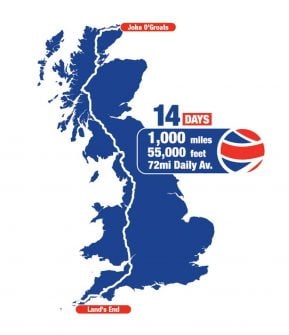
2. Distance from Land’s End to John o’ Groats (and how long it takes)
How far is Land’s End to John o’ Groats?
As the crow flies, the geographically direct route between Land’s End and John o’ Groats is 603 miles (970km).
The fastest route (by road) between the two points is often debated, but the most quoted distance is 874 miles (1,406km). However, this is not a route you would want to cycle on!
How long does it take to cycle LEJOG?
There’s no set rule for this. People undertake LEJOG across a wide range of days and a variety of distances. Also remember to add a day on at the start and finish of the cycling route to allow for travelling.
21 Days
For those of you with plenty of time then I’d recommend the Sustrans route of 21 days which enables you to really take your time, explore areas in more depth and choose even more remote roads.
14 Days
Most common is the 14-day 1,000 mile option. The reason we opt for this on our trips is that it strikes the balance between speed and being able to pick the best road. It means we can avoid many of the main urban areas and you can mainly cycle on quiet, country roads.
At 71 miles average per day, the longest day we do is 87 miles and the shortest is 50 miles. The route has a total ascent of 55,000ft and it provides a tough challenge, whilst still allowing for time to take in your surroundings. You can spend up to 8 hours per day in the saddle, so be prepared.
9 Days
Another popular option is the 9-day Ride Across Britain challenge, which with an average of nearly 100 miles per day, is targeted more at cyclists wanting to test themselves to the very limit of their capability. With those kind of distances, enjoyment is a secondary consideration!
And less….
When you hit 5 or 7 days you are into ultra cycling territory usually only attempted by those raising money for charity or looking for bragging rights at the cycling club!
The point is that whatever your aim, be it a personal challenge or simply a desire to experience the incredible beauty of the UK from the saddle of a bike, LEJOG can be tailored to suit your needs.
3. Land’s End – John o’ Groats cycling record
Point-to-point challenges have held a certain allure for cyclists for generations – and none more so than LEJOG. As far back as the 1800s people were attempting to compete for the fastest time on this route!
Records…
LEJOG attracts people trying to beat records on all sorts of bicycles from penny farthings to virtual bikes. The current Land’s End John o’ Groats cycle record time (based on speed) is 41 hours, 4 minutes and 22 seconds. This was set by Andy Wilkinson who rode a Windcheetah recumbent tricycle.
One of the newer Land’s End to John o’ Groats records was set by three cyclists on a triplet bicycle. They completed the route in 6 days 13 hours and 30 minutes.
We also have our own ‘unofficial record breaker’; in August 2019 Brian Lewis (82 years) came on one of our trips and became the oldest Octogenarian to cycle LEJOG in the shortest time. Proof that if you are fit enough you are never too old to take on LEJOG!
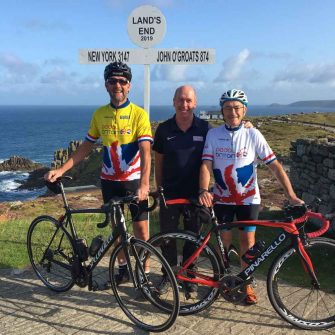 With Brian Lewis, at 82 the oldest person to complete LEJOG with us
With Brian Lewis, at 82 the oldest person to complete LEJOG with us There is always a group riding at a pace to suit you
There is always a group riding at a pace to suit you…Or ride at your own pace
A more normal speed to ride LEJOG is 10-14 days.
My philosophy is that you should ride LEJOG at your own pace.
On our tours you will usually get three or four groups forming, each with its own characteristics in terms of pace, photo stops and time spent at brew stops. Generally the average pace of these groups ranges from 15mph to around 11mph. Also these groups are fluid depending on how you feel and if you fancy a few miles alone, that is no problem.
4. Land’s End to John o’ Groats cycle routes: how to plan the best one for you
The million dollar question – what is the best route from Land’s End to John o’ Groats!
Which LEJOG route to take?
There is no “classic” Land’s End to John o’Groats cycle ride route.
There are thousands of different alternatives and sorts of route you can take depending on the time you have and your objectives – ask yourself how important scenery, speed, accommodation and visiting specific places are to you?
That said, many people prefer to experience the western side of Scotland, past Glasgow to Fort William and along Loch Ness, due to its famous lochs and mountain passes. There are any number of alternatives, including riding up the east coast of Scotland which is probably less busy and flatter, but also perhaps not as classically spectacular.
I’ve mentioned a few roads it’s important to miss in the Tips section below.
I also set out what to expect from our 14 day LEJOG route below. Hopefully it will give a good idea of the kind of riding to expect, even if you end up doing a slightly different route!
Planning a LEJOG route
You can find LEJOG GPX route files that people have done before by looking at online route planning tools such as Ride with GPS and Strava.
You’ll need to check any route you download very thoroughly – don’t assume it’s the best route out there or on the best roads. However, once downloaded a GPX route can easily be adapted to whatever preferences you have in terms of the route, daily distances and overnight stops.
You can also consider route information on sites like the National Cycle Network, Cycling UK and Sustrans websites.
Beware, planning your own route will take a lot of time to perfect!
Our Land’s End to John o’ Groats cycle route
The route for Pedal Britain’s LEJOG is created from a combination of my own experience of cycling end to end in 2013 and Nick Mitchell’s excellent book ‘End to End Cycle Route: Land’s End to John O’Groats.’
I chose the LEJOG route that incorporated many of the areas and iconic landmarks that I thought our clients would want to see, such as Dartmoor, the Lakes, the Wye Valley and western Scotland.
Over the years, I’ve refined it to incorporate improvements, recommended from books and clients local to certain areas who have tipped us off about minor roads and scenic options. For example, we now cycle eight miles of canal paths to avoid busy roads around Warrington and the excellent compacted gravel paths alongside the Caledonian Canal to avoid the A95 into Fort Augustus.
LEJOG route versus JOGLE route
Start at the bottom and do the Land’s End to John o’Groats route or start at the top and do the John o’ Groats to Land’s End route. Which is better for cyclists?!
There are a number of myths about JOGLE v LEJOG, the most common being that the JOGLE route is easier as you are going downhill. In actual fact, Land’s End’s signpost, perched on a cliff top, is higher than John O’Groats, which is almost at sea level.
It can be argued that the traditionally feared days of Devon and Cornwall are easier on JOGLE, as you’ve ridden yourself fit by time you reach them. But if the wind is blowing the wrong way on day 1 of JOGLE there is no harder cycling test in the UK than along the north coast of Scotland!
The main reason we chose LEJOG over JOGLE, is that the prevailing wind is from the southwest. This means, for the most part, this wind should be helping riders.
In reality, whether you ride Land’s End to John o’ Groats or John O’ Groats to Land’s End is purely personal and often down to where you live. For example, people from Cornwall may want to finish in the south so that family can join them at the end.
But we find the majority of cyclists want to complete the journey in the more classic direction of Land’s End to John o’ Groats.
LEJOG with Pedal Britain
To find out more about doing LEJOG with Darren and the team, head to their website!
You might also want to check their Trust Pilot page.
5. Day by day on the LEJOG route
Below I’ve set out a taster of what to expect on each day of our Land’s End to John o’ Groats bike ride. Of course, you might choose to do a different route, but this gives you an idea of the kind of distances and landscapes you’d see on one of our trips.
Day 1 – Land’s End to St. Austell
60 miles | 100km | 5,309ft | 1618m
This is the day cyclists fear the most. It is a tough first day in the saddle, but it’s not the hardest of the route. Cornish hills tend to be short and sharp; they’re not particularly long, it’s the frequency of them that provides the challenge.
This route takes in the south Cornish coast road via Penzance and with stunning views across to St Micheal’s Mount. Heading inland on quiet, narrow country lanes, with customary high hedgerows and through tranquil villages, you begin to earn the fabulous cream tea lunch we provide – a must do in this area!
A wonderful feature of this day is crossing the river Fal on the ‘King Harry’ chain ferry (one of only five in the UK). It connects St Mawes and Roseland Peninsula with Truro – avoiding the 27 mile alternative route…
After crossing the river, a longish climb leads to an afternoon exploring deeper into rural Cornwall, before spending Sunday evening in St. Austell.
 Cup of tea with a view of St Michael’s Mount
Cup of tea with a view of St Michael’s Mount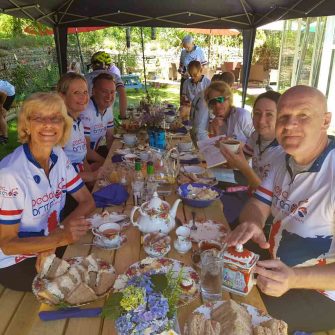 Cream tea break!
Cream tea break!Day 2 – St. Austell to Moretonhampstead
71 miles | 114km | 5,870ft | 1789m
A ferry takes you across the River Fowey, after which you are bowling along the Cornish coastline, passing through seaside towns of Seaton and Looe towards Plymouth.
A highlight of the day is the Cremyll ferry ride that takes you from Cornwall into Devon, with lunch overlooking the historic Naval Harbour.
The afternoon starts with 8 miles through the peaceful Plym Valley, before ascending into the rugged splendor of Dartmoor. There are fantastic views from Sharpitor, a tough 18 miles through the National Park via Princeton to Moretonhampstead.
 Arriving in the Cornish town of Seaton
Arriving in the Cornish town of Seaton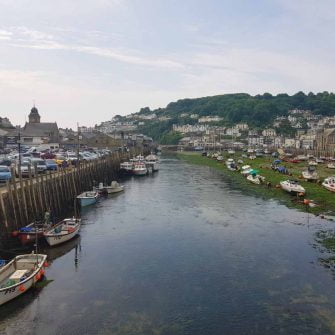 The beautiful harbour at Looe
The beautiful harbour at LooeDay 3 – Moretonhampstead to Wookey Hole
83 miles | 133km | 4,236ft | 1291m
The morning starts with a gorgeous wooded climb as the route takes the scenic route towards Exeter.
There’s more climbing to come in the quiet roads of Devonshire, with short climbs and quick descents.
We eventually find flatter ground in Somerset, cycling through quirky Glastonbury and parts of the Somerset Levels. We visit the historical town of Wells, before the short ride to our overnight accommodation at the famous Wookey Hole.
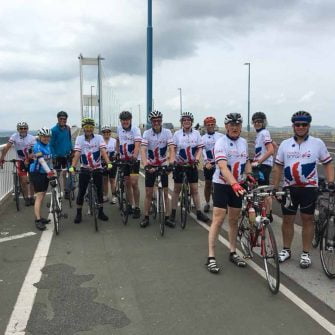 Riding over the Severn Bridge to Chepstow
Riding over the Severn Bridge to Chepstow Wells Cathedral
Wells CathedralDay 4 – Wookey Hole to Hereford
76 miles | 122km | 4,868ft | 1483m
Today starts with an optional detour to climb Cheddar Gorge, a fantastic experience if you have the energy.
The route traverses across the Mendips via Chew Lake, towards Bristol and across the Clifton Suspension Bridge. After navigating through Bristol there is a memorable ride over the Severn Road Bridge on the dedicated cycle path to Chepstow, as we make our way into Wales.
After lunch in the shadow of Tintern Abbey, we cycle along the Wye Valley AONB towards Monmouth and on to historic Hereford. This is a truly glorious part of the tour.
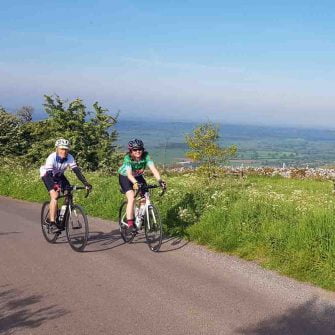 Day 4: stunning views climbing the Mendip Hills
Day 4: stunning views climbing the Mendip Hills Day 5: having lunch in Clun
Day 5: having lunch in ClunDay 5 – Hereford to Shrewsbury
67 miles | 107km | 3400ft | 1036m
A day of picture perfect villages, we take quiet country roads and lanes as we wend our way towards medieval Shrewsbury where we stay for the night.
Lunch is in the rural village of Clun, with its castle ruins. It’s also home to the Clun Brewery. A shorter day means arriving in good time to explore medieval Shrewsbury or take advantage of Dave Mellor’s bike shop for repairs.
Day 6 – Shrewsbury to Leigh
72 miles | 115km | 2,300ft | 701m
What we jokingly call the tour’s ‘rest day’, is a much easier ride than previous days along quiet rural lanes, canal paths and through lush green countryside on the flattish terrain towards Leigh in Lancashire.
There’s a morning coffee stop in the pretty village of Hamner, overlooking its open swimming lake, which provides an opportunity for the brave to take a dip! After lunch near Mickle Trafford, the afternoon is spent navigating cycle paths to Leigh.
 Day 6: Break with a view in Hamner
Day 6: Break with a view in Hamner Day 7: Tackling “The Cross of Greet” in the Forest of Bowland
Day 7: Tackling “The Cross of Greet” in the Forest of BowlandDay 7 – Leigh to Kendal
69 miles | 111km | 4656ft | 1419m
We leave Leigh early on Saturday to miss the traffic through Bolton. From there we climb on to the moors that provide a stunning view across this industrial landscape towards Manchester.
Once through Blackburn, we approach the quieter roads and the impressive Forest of Bowland and lunch at its heart in Slaidburn.
After this, the route ascends via a UK Top 100 Climb ‘The Cross of Greet’ onwards towards the Yorkshire Dales village of Kirkby Lonsdale. After briefly stopping at the Devil’s Bridge we head into The Lakes and Kendal, our stop for the evening.
Day 8 – Kendal to Gretna
76 miles | 138km | 5,208ft | 1587m
Heading north into the Lake District we pass through Grasmere, then a tranquil traffic-free ride alongside Thirlmere Lake takes us via Castlerigg Stone Circle and stunning landscapes towards Keswick.
After lunch in the shadow of Skiddaw, we turn east through the Caldbecks onwards to Gretna Green. There are fantastic views across the Solway Firth enroute.
A must-do is the obligatory picture at the “Welcome to Scotland’ sign at the border.
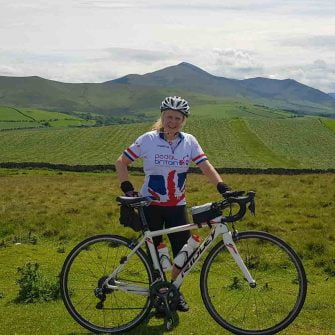 Amazing views from the Caldbecks back towards the Lakes
Amazing views from the Caldbecks back towards the Lakes Castlerigg Stone Circle is worth stopping at
Castlerigg Stone Circle is worth stopping atDay 9 – Gretna to Larkhall
76 miles | 122km | 3,500ft | 1066m
The cycling today is relatively easy, through the brooding beauty of the Scottish Lowlands, where majestic purple covered hillsides and dark lochs lure us deeper into the heart of this incredible country.
After lunch, in the busy town of Moffat, we wind our way through river valleys towards our overnight stop in Larkhall.
Day 10 – Larkhall to Tyndrum
79 miles | 128km | 2,397ft | 1298m
The traffic-free River Clyde cycleway see you traverse Glasgow and head towards the Trossachs.
The cycle path through Glasgow is a great way to see this vibrant Scottish city, with numerous traces of its shipbuilding history still visible and a chance to buy whiskey from the Clydesdale Distillery.
From our lunch stop near Balloch on the banks of Loch Lomond, we often watch seaplanes swoop into land. Our LEJOG route follows the cycle path that runs along Loch Lomond’s western shore, to Tarbet and on to our evening stop at Tyndrum.
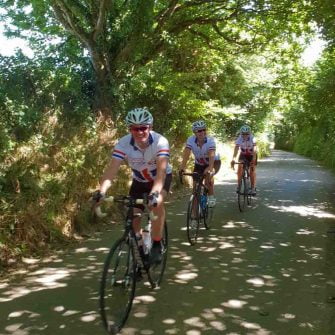 Day 9: Quiet country lanes
Day 9: Quiet country lanes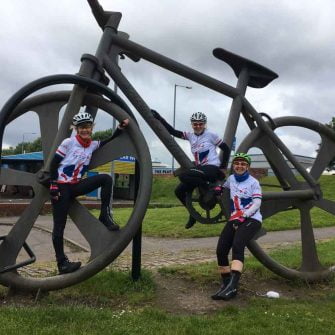 Day 10: Bankies Bike on the Clyde cyclepath
Day 10: Bankies Bike on the Clyde cyclepath.
Day 11 – Tyndrum to Fort Augustus
79 miles | 128km | 4,259ft | 1298m
For many, this day is a highlight of the tour.
We cycle from Tyndrum on spectacularly scenic roads onto Rannoch Moor and through the magnificent Pass of Glencoe.
We pause here to take in the dramatic landscape, before dropping down into Glencoe village and pushing onwards to Fort William.
We have a final break at the Commando War Memorial and on a clear day we get amazing views of Britain’s highest mountain, Ben Nevis. There’s then a lovely ride alongside the Caledonian Canal, to beautiful Fort Augustus, situated at the head of Loch Ness.
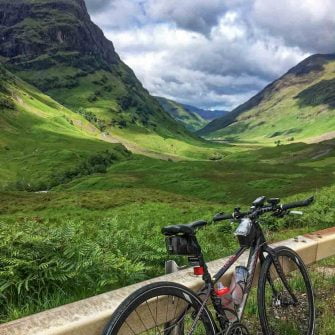 Day 11: Amazing views of Glencoe
Day 11: Amazing views of Glencoe Day 12: Lunch stop in Dores, Loch Ness
Day 12: Lunch stop in Dores, Loch NessDay 12 – Fort Augustus to Invergordon
62 miles | 100km | 4,278ft | 1303m
First thing in the morning, we stretch our legs on the toughest climb of the entire tour, when we ascend on to General Wade’s Military Road.
The views at the top of this climb are breathtaking. Another benefit is a fast descent to Loch Ness and lunch on its banks in Dores, before heading towards Inverness, the capital of the Highlands.
Having passed through Inverness, we cross the Kessock Bridge, with some great views across the Cromarty Firth before ending on its banks at Invergordon for the evening.
Day 13 – Invergordon to Bettyhill
77 miles | 123km | 3,314ft | 1010m
Today is most often quoted as ‘best of the tour’, and I cannot disagree.
The day begins with a long and steep climb onto the ‘Struie’ where we will be rewarded with some epic views across the Kyle of Sutherland and the Carbisdale Castle at Invershin.
There’s a long, exhilarating downhill ride to Bonar Bridge. We ride through the village of Lairg and alongside Loch Shin into proper wilderness before climbing to lunch at the famously isolated Crask Inn.
The next stretch of cycling is my favourite on the whole tour. We descend to Altnaharra, then under the shadow of the towering Ben Klibreck the route takes us on the single-track road alongside Loch Naver. Expect to pause many times to capture the amazing views!
We stay at Bettyhill for the evening and you’ll be greeted with the almost tropical sight of white sandy beaches and wild seas of the north Scotland coastline.
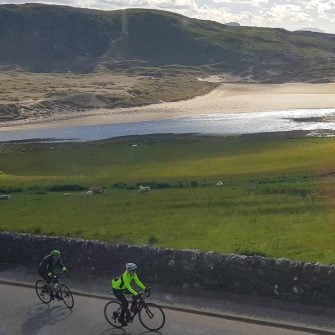 The climb to Bettyhill Hotel
The climb to Bettyhill Hotel Cycling stunning Loch Naver
Cycling stunning Loch NaverDay 14 – Bettyhill to John O’Groats
50 miles | 80km | 2,783ft | 848m
This is the last cycling day of the tour.
There are a couple of steep hills between Bettyhill and Strathy that will test weary legs for the final time. If the wind is in the wrong direction then this can be a tough ride.
The final few miles to John O’Groats are relatively flat, but emotional, as we re-group to ride them together, finishing in front of the famous signpost where champagne awaits, followed by a celebratory meal.

6. Navigating the LEJOG route
Land’s End to John o’ Groats maps
Before digital maps or GPS navigation systems, cyclists doing LEJOG would have to rely on paper maps. The best option for paper route maps is the Ordnance Survey range, the most detailed being Explorer maps – which would require 54 maps to cover Land’s End to John O’Groats!
GPX file of Land’s End to John o’ Groats/LEJOG route
These days, online route planners take a lot of the stress out of route planning (there’s more on creating your LEJOG GPX route above and check out this article for general cycle route planning tips).
However, if you’re planning to be completely dependent on GPS routes for your navigation, have a serious think about also bringing a small portable battery pack in case you forget to charge your cycling computer or phone overnight.
What help do you give your clients with navigation
For customers wanting to do it the traditional way, we issue detailed turn-by-turn route notes. These can be mounted on the handlebars in a clear waterproof map holder. I’m always surprised by how many people still prefer this!
We also provide our cyclists with access to a specific LEJOG event area on Ride with GPS. From here they can download the GPS files in the format required and upload them again easily to their navigation device of choice.
The free Ride with GPS app also turns your mobile into a GPS turn by turn navigation device – useful if you do not have a Garmin / Wahoo and a great back up if you do. Mount it on your handlebars and away you go.
The Ride with GPS app lets you download the route maps and store them on your phone, giving ‘offline’ access in areas of poor signal.
Finally, we also ask clients to download a tracking app to their phone. This means we can find them and they can also see where we are.
These things really do take the stress out of navigation!
More about LEJOG with Pedal Britain
To find out more about doing LEJOG with Pedal Britain, get in touch with Darren and the Pedal Britain
team!
You might also want to check their Trust Pilot page.
7. Accommodation on the LEJOG cycle route
One of the big things to be arrange on a LEJOG attempt is accommodation; a new place each night.
Types of Land’s End to John o’ Groats accommodation
The type of accommodation available when doing LEJOG really depends on your budget, route and how flexible you’re willing/able to be.
In most parts of the country there’s a good range of accommodation, from campsites to B&Bs and hotels.
However, bear in mind that if your route doesn’t deposit you in the middle of a big town – and if you’re in less populated parts of the country, there will be less accommodation available. I’d definitely recommend booking in advance for Scotland, the Lakes or Cornwall, especially during peak seasons.
Wild camping is becoming another popular way to do LEJOG. There’s the obvious advantage of being totally flexible and very cheap – you just need to make sure you’re doing it in a way that’s legal (far easier in Scotland than England).
It is also very feasible to plan a route that incorporates a large number of YHA/Bunkhouse accommodation, supplemented with B&Bs to provide that extra level of comfort versus camping.
Bike-friendly accommodation on the LEJOG route
While there may be a good number of places you could potentially stay on the LEJOG route, some are better than others in terms of welcoming cyclists. Some of the things we consider when selecting accommodation are whether they
Over the years, we have developed excellent relationships with our hospitality partners. They reflect our philosophy about customer service and they are very sensitive to our needs as a cycling group; they’ll cover off the points above and more.
Our guests often tell us that not having to worry about accommodation reservations (or transporting their luggage) makes the whole LEJOG experience enjoyable and hassle free.
Indeed, to make riders’ lives easier, we also make dinner reservations – as the last thing you want to do after a hard day in the saddle is wander around trying to find somewhere to eat in the evening! (You can also choose not to dine with the group and indeed we have two nights where we encourage this and provide a list of nearby restaurants to help.)
Booking accommodation in advance
The accommodation conundrum is the reason we most often get as to why our guests have opted for our tour rather than a self-guided trip.
The issue is what to do if for some reason you get delayed – whether due to a mechanical or illness/accident. Having to deal with all the accommodation providers remaining on the trip would be time consuming and potentially costly depending on what cancellation policies the providers have.
This then leads to the need to dig into the detail of hotel cancellation policies before you book – as well as the dilemma of whether to book all the accommodation or chance it and book as you go.
If travelling alone or as a couple, and you haven’t got strict requirements over when you need to get back home, you could remain super flexible and book accommodation as you go. So long as you’ve planned to arrive in a relatively large town you’d generally be able to find accommodation – albeit you may not have much choice. There’d also be the possibility to add in an extra day of cycling or a rest day if accommodation wasn’t available.
If you’re on a time limit or travelling as a larger group, booking as you go becomes more difficult…
8. Packing list for a LEJOG
Below you’ll find the kit we recommend our guests bring on one of our trips. One of the benefits of a supported tour is that you haven’t got to lug all this stuff yourself!
Gear
For you:
Cycle Helmet
Cycling glasses
2 x water bottles
Portable battery pack – to keep GPS/phone batteries charged during the long days
Spare SPD cleats – useful as you’ll do a lot more walking in your bike shoes
First aid kit – to carry with you; our support van has comprehensive kit
Your bike – serviced and in good condition
For your bike:
Cycle computer – with navigation function
Working lights (front and rear) – a good idea to have these on at all times, even during the day, to aid your safety and essential in poor visibility.
Pumps – hand pump essential and CO2 pressure pump is optional
Spare brake pads
Spare inner tubes – minimum 3-4 recommended
Bike multi-tool
If your bike has any ‘non’ standard parts that may not be held in a bike shop please consider bringing a spare along.
Spare spoke – many bike shops do not hold specific ones in stock. Saves buying a new wheel!
Bell – we occasionally share same paths as pedestrians
Medium saddle bag – handy for camera, mobile, wallet/purse and essential tools for repairing a puncture.
Optional:
Puncture repair kit – optional if you bring spare tubes
Back pack (if you can’t fit the following elsewhere) – to carry waterproofs, first aid kit and food
Bike wing mirror – can be handy for the busier roads
Map holder on handlebars, with waterproof cover – not needed if using Garmin or GPS device
Clothes
1 x wind-stopper soft shell jacket
1 x cycling gilet
4 x cycling jerseys – bright yellow, pink, green tend to attract more insects
3 x cycling shorts
3 x cycling socks
2 x cycling gloves – short and long fingered
Waterproof over jacket – ideally this will be high visibility colour
Waterproof trousers
Waterproof overshoes
Cycling shoes with preferred cleat system
Clothes for the evening – comfortable casual wear will suffice
Optional
Arm warmers – not essential but useful for chilly mornings
Other essentials
Toiletries
Antiseptic wipes
Antiseptic hand wash liquid
Mobile phone (and charger)
Money/cash card
Sunglasses
Camera
2 x clothes hangers – for drying wet kit
Sun cream
Insect repellent
Lightweight medical supplies – antihistamines, ibuprofen, antiseptic cream
Optional
ASSOS cream – or similar essential daily care for your rear
USB Multi-Plug Adaptor – useful if carrying multiple devices that need charging overnight
9. Best bike for a LEJOG
Most people on supported tours will do LEJOG on a road bike or lightweight hybrid. These are fine as the most you’ll be carrying on the bike at any given time will be a saddlebag for essentials and perhaps some waterproofs.
If you are riding unsupported, you’ll need a specialist touring bike with panniers designed to carry much more in the way of luggage. These bikes should also have more gears to haul the extra weight up the hills!
Most people doing the LEJOG will travel on-road, perhaps with a few railway paths or canal towpaths thrown in to avoid busy roads. If you plan your own route, just make sure that your bike is suitable for the surfaces you’ll be riding on.
10. Best time of year to do a LEJOG
Most people attempt to ride Land’s End to John o’ Groats between May and the end of September.
Any earlier than that and you have issues with having enough time to get fit beforehand – along with highly unpredictable weather.
Any later and you run into issues with available daylight to safely ride and you’re also more likely to encounter storms.
Being Britain, there really is no consistently ‘best’ time from a weather perspective to do LEJOG. We have had tours in June where they’ve had rain for 14 days and others where it has been 30 degrees, both are equally challenging in their own way!
I personally enjoy riding in September, as although it can be chilly first thing you tend to get the most stable weather in Scotland and there are no midges. Also, being outside holiday season, there is less traffic on the roads.
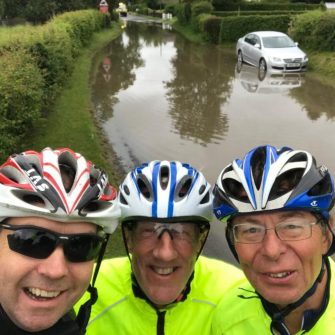 Even in June, the weather can be unpredictable
Even in June, the weather can be unpredictable The same June tour four days earlier!
The same June tour four days earlier!11. Mechanical issues on a LEJOG
Definitely get your bike serviced at your usual local bike shop before heading off on LEJOG.
It’s also sensible to go for at least two or three rides on the newly serviced bike, before your LEJOG, especially if new brake or gear cables have been fitted. This helps bed them in and you can make adjustments as necessary to compensate for them stretching before the tour.
What sort of mechanical issues should you be able to deal with before doing LEJOG?
If you are planning to do LEJOG unsupported then I’d recommend that you are either qualified to CYTEC Home Mechanic level, or have enough knowledge to deal with many of the frequent issues that arise such as new gear or brake cables, adjustments to gears, mending chains and fitting new spokes.
What spares and tools should you take?
Our kit list sets out what we recommend our clients take on our supported tours. If you’re on an unsupported tour, you’ll have less back up and so might need more in the way of spares.
For more serious mechanical issues you’ll likely need a bike shop for permanent fixes, but by having certain spares such as chain links and an emergency derailleur hanger means you can at least get the bike to either the next overnight stop or bike shop. Bear in mind though that these patch ups still require a certain level of knowledge and a comprehensive toolkit.
Bear in mind that you should do some basic servicing on your bike while you’re on LEJOG, to keep it running well. If you’re self-supported you might want to bring materials; on our trips we provide the required cleaning materials.
Bike shops on the LEJOG route
Bike shops on LEJOG routes are usually incredibly helpful. They fully understand that you are on a timeline and will generally go above and beyond to keep you moving.
We find that so long as we call ahead and they have parts they’ll usually jump you ahead in the queue so that any impact is minimal.
We’ve found Dave Mellor’s in Shrewsbury particularly helpful. Shrewsbury comes five days into the trip, which is when people tend to realise they need something doing or they want that annoying squeak sorted or just require new brake pads! We’ve found that the shop will even stay late or get in early to help out.
Another trick is ordering kit or parts online is to arrive at the accommodation or bike shop a day or two ahead. Just make sure you clear it with the owners!
Support on a Pedal Britain trip
We’re often told that mechanical support is a major factor in why riders choose to take an organised tour with us, as opposed to being independent.
All riders need to know how to mend a puncture and should do so themselves wherever possible. However we find that as cyclists are riding in groups, they often wait for each other and fix punctures as a team effort, to keep things moving smoothly.
Having a van with track pumps and driver/guide close by, to help if needed, is also comforting.
On every LEJOG our support van carries two spare bikes and on most tours they will get some use, although usually only for part of a day. Whilst the support van is not a mobile bike shop, we do carry a comprehensive tool kit, have some generic spares and a bike stand for running repairs. However if you have a bike that requires non-standard parts, bring them with you!
Want more info about Pedal Britain?
Get in touch with Darren and the Pedal Britain
team!
Head to their website to find out more about their LEJOG trips – and other supported end to end challenges.
You might also want to check their Trust Pilot page.
12. LEJOG cycle training
The question of fitness and training is one of the most common ones we get from clients.
What are your tips for training for LEJOG
I’m often asked, “can you send me a generic training schedule please?”
My answer is simply no.
My reason for this is that I think the ‘vanilla’ style training plans that can be found easily on many websites linked to LEJOG actually do more to deter people than encourage participation.
They very often exaggerate what is required to successfully complete LEJOG because they are designed for a highest need scenario – couch to LEJOG in four months.
Our formula for training is a simplistic framework that can be adapted for all needs. We recommend as a rule of thumb that in the 10-12 weeks leading up to the tour you are cycling at least 100 miles per week. If you are doing this, you can complete LEJOG.
Obviously, the more you do, the easier it becomes.
Also bear in mind that your body should be less prone to injury on the LEJOG if you’ve had a sensible build up.
Our aim is that you ‘enjoy not endure’ LEJOG, which is why we also partner with Grant Goodman who provides specific packages targeted at improving our clients performance.
How fit do you need to be to do LEJOG?
As mentioned, we’d recommend you are cycling at least 100 miles per week in the build up.
In terms of speed, we find several groups tend to form naturally, ranging from 14-15mph at the front to 11mph, the key being no group gets held up by another or has its pace dictated to by a guide. This means you never need to cycle beyond what you have trained to do or want to attempt.
Ideally you’ll have ridden the longest distance of your tour a few times before going. But if you are cycling three-quarter distances at least once a week then your body will adapt to the extra required as your pace on tour is likely to be slower.
If you are cycling slower than 10mph then we’d perhaps suggest doing LEJOG over a longer time period than 14 days, as that would mean some very long days in the saddle.
Do you need to do multi-day rides ahead of LEJOG?
Being 14 days long, it is just not practical to do a “practise” LEJOG (even one of the LEJOG virtual challenge events that have sprung up!).
But in training you can provide yourself with some mental reassurance and hone your body by doing consecutive days in the saddle. These should be two or three back-to-back days riding at three-quarter distance, so say 50 miles per day.
You should also consider seeking out some hills if the area around you is really flat… Strength training can also be a good idea.
Some people that live close to the route will try a particular day out to also provide further comfort that the degree of difficulty is not beyond them.
13. Tips for a successful LEJOG cycle trip
Route choice
There is a huge temptation when doing LEJOG to choose a route simply because it fits a particular objective, as opposed to leading with safety first.
If you’re planning your own route, do a thorough and careful job; don’t scrimp on safety or route planning. Consider using Google Street View if you’re ever unsure about a road. These pointers might also assist:
Cornwall
One road you must avoid at all costs is the A30 through Cornwall. Sadly, too many inexperienced cyclists wanting to take the shortest route to minimise miles use this and have ended up being seriously injured or killed on this very busy road. Local drivers will go so far as to stop and warn cyclists if they see them. There are numerous routes out of Cornwall, both along the north and south coast that are safer and more scenic.
Large towns/cities
Large conurbation areas such as Manchester / Liverpool should also be avoided where possible, especially during Friday afternoon rush hour. With numerous busy A roads and junctions over motorways, the roundabouts here can be challenging to navigate around.
Scotland
In Scotland, if travelling on the east coast route to John o’ Groats do not be tempted to cycle along the A9 or A99. These are again very busy roads and can easily be avoided without compromising on the scenery.
The A95 route on the west coast can also be challenging for cyclists as it becomes quite narrow in places. Being a main commerce and tourist link road, it is also busy with coaches and lorries.
Avoid big pelotons
Safety is hugely improved when riders are not cycling in large groups.
On busier sections of road, we suggest clients ride in twos, with several coach lengths between them and the next pair. Riders stretched out in a peloton are what make these roads dangerous, with vehicles becoming impatient to overtake. Simple considerate cycling keeps everyone happy and safe.
Nutrition
The biggest risk on a multi-day cycling tour is running out of energy and not drinking enough, which leads to the dreaded ‘bonk’. Little and often is the best ride management approach so you never reach the point of feeling hungry or thirsty on the bike.
You cannot go 10-14 days fuelled by coffee, gels, bananas and energy powder in every water bottle. Consider “real food” such as a bag of nuts or crisps in the afternoon and eating jellied sweets instead of that extra gel. If you treat each day like a training ride then I guarantee your stomach will quickly go into “reject mode” by Day 4!
On a Pedal Britain ride you’ll be stopping at least three times during the day for food and drink. Our famous brew table provides a full range of options and our nutritious lunch stops are something to look forward to.
Off the bike routine is equally important, as your metabolism by day 5 is in overdrive meaning that eating enough food in the evening is very important. A protein snack within 45 minutes of finishing is also a good idea. If you do not eat enough then you’ll find your body will wake you up in the middle of the night, hungry!
 Break stop on a LEJOG
Break stop on a LEJOG Lunch by Loch Lomond
Lunch by Loch LomondHydration
For hydration always carry two bottles on the bike (ideally 750ml).
Our rule thumb is you have 1 x bottle with energy power, 1 x plain water and for every 20 miles you should be drinking at least 500-750ml of fluid (weather dependent – obviously more if hotter).
Highs and lows
Everyone has a low day on a cycling tour of this length, be it physically or mentally.
Breakfast on day 1 of the ride is often a very quiet affair as riders contemplate the challenge that lies ahead.
The ‘Day 1 blow out’ is where people ride harder and faster than they can sustain from the start. Caused mainly through the release of the excitement and nervous energy of finally participating in LEJOG. It can also be a function of simply not knowing the riding ability of those around you and being dragged along, trying to keep pace with them, as opposed to finding a more suitably paced group.
Another common point where spirits are tested is on Day 8. After the euphoria of crossing the border into Scotland the temptation is to think ‘you’re almost there’, however the realisation that you still have 6 days to go can be tough. So that evening in Gretna we hold what we call our ‘MAD Awards’ to lighten the mood – essentially just some fun certificates for things that have happened on the tour so far.
Mental tricks to keep cycling when you’re tired
You cannot underestimate the importance of being mentally fit to take on LEJOG. This starts with being in the right positive frame of mind; you’ve done the training now time to enjoy the experience.
So many riders spend time worrying about the hills and what is coming up opposed to enjoying the moment. “What are the hills like today Darren?” – is the most asked question on any tour. I’ll always answer honestly and reassure where I can see someone is concerned, but mostly I’ll deflect it by saying “Nothing you have not done before.”
I also make a point of getting people to break a day down into smaller bite size pieces to help combat physical and mental tiredness. It’s easily done as most days on tour are divided into three distinct sections of Morning Brew Stop, Lunch and Afternoon Brew Stop. Which is why in the morning we issue our ‘Magic Numbers’ essentially the distance to each stop. This makes the focus the next 20-25 miles opposed to a full day.
Also if you are raising money for a good cause, I recommend using this and the people supporting you as motivation when you hit a low point in energy. I’ve used this myself numerous times on charity rides to get me through tough periods.
How to get to Land’s End by train
Assuming you don’t want to leave your car at Land’s End, the best way to arrive is by train. Penzance is the nearest railway station to Land’s End, roughly 12 miles away.
Train services to Penzance are operated by GWR and CrossCountry. You’ll need to book your bike on the train as far in advance as possible, including a bike space. The best way to do that is in person at a railway station as we’ve found that booking office staff can sometimes seem to find a bike space when the online systems say there are none. It’s also sensible to reserve a seat near to the bike compartment if you want to keep an eye on your bike.
How to get back from John o’ Groats by train
For the return trip, there are train stations at Wick, 16 miles from John O’Groats and Thurso, 20 miles away. Services are run by ScotRail and booking is also needed here. Train services are not quick and to get to England in one day from Wick or Thurso you’ll need to get an early morning train. You could also consider the Caledonian Sleeper from Inverness.
Other transport options
Other options are to courier your bike to the start/finish (there are specialised companies that will do this) or you can courier it to a local bike shop.
Finally, you could consider hiring a car. You can leave it with Europcar in Penzance – and pick one up from Hertz at Wick airport near John o’ Groats.
14. Self-supported vs. supported LEJOG
You can certainly do LEJOG without the need of a tour company such as Pedal Britain.
Self-supported
Full on panniers to many is the purist’s way of completing the UK end to end, as it affords complete independence and flexibility compared to the more structured approach of a supported tour.
However it can be very tough doing LEJOG alone – and do not underestimate the organisation required. It’s definitely not an option for the inexperienced. But it does mean you can plan each day around how you are feeling, so where you stop for breaks, lunch and overnight.
This kind of approach is definitely more suited to individuals and very small groups.
Friends and family support crew
A hybrid option that is common with varying sized groups is to rope family or friends in to act as your support crew. This means you have the reassurance of backup if anything does go wrong and places
The self-supported and friends and family options are the cost-efficient route to take.
Supported tour
If all you want to focus on each day is getting on your bike and pedal, then choosing an operator such as Pedal Britain to take away all the organisational hassle is the best option – but as you’d expect, such convenience comes at a price.
A supported tour is definitely comparatively expensive compared with the self-supported/friends and family route.
The advantage is the reassurance of van support, which carries your luggage, and tour guides who can provide any mechanical and first aid assistance as required. Indeed the support starts before you even book with a comprehensive FAQ section on the website, along with guidance and optional coaching packages relating to training for the tour.
All of your accommodation is booked, lunch is provided along with brew and snack stops in the morning and afternoon, plus we’ll even reserve tables for the evening meal.
The van is fully equipped with cleaning materials and there’s no need to carry anything very much on your bike.
Want support on your LEJOG?
Pedal Britain would love to help!
Head to their website to find out more about their LEJOG trips – and other supported end to end challenges.
You might also want to check their Pedal Britain’s Trust Pilot page.
15. LEJOG with Pedal Britain
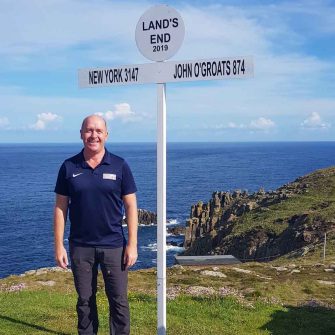
I’m from Northamptonshire and before setting up Pedal Britain, I cycled all over the UK and Europe with a number of different cycling tour companies, as a paying client.
It was because of the poor experiences I had with many of them that I decided to set up Pedal Britain.
Issues I encountered with other operators included poor pre-tour communication and documentation, limited training support and guides with little or no interest in customers (they seemed to just be having a holiday themselves!)
I also didn’t enjoy being forced to ride at a certain pace, poor accommodation and very large groups of up to 30 people that left little scope for good customer service.
I wanted to set up a business that addresses the issues I experienced and puts customers at the heart of everything we do.
To this day, customer service is what motivates me and it’s at the core of every decision we make. I couldn’t be more proud that this is reflected in our Trustpilot reviews.
Our aim principle is to make your cycling holiday as hassle free and enjoyable as possible. That’s why our tagline is “We Take Care of Everything, You Just Pedal Britain.”
16. Find out more about LEJOG with Pedal Britain
Find out more about us here:
www.facebook.com/pedalbritaineurope
www.instagram.com/pedalbritaineurope
17. You’ve done LEJOG. What next?
The camaraderie that develops over the duration of the epic journey that is LEJOG creates a special bond between riders. WhatsApp groups buzz for many months after with newly found cycling buddies planning the next trips together – which is also a good way of getting over the inevitable ‘post tour blues’!!
Luckily Britain still has plenty of fantastic rides to challenge you such as a 3-Day Wales End to End tour from Chepstow to Caernarfon. This lesser known but stunningly beautiful end to end can be completed in just a long weekend. It incorporates some incredible landscapes, from the views across the Wye Valley from the Gospel Pass in the Brecon Beacons to a top 100 climb, Bwlch y Groes.
Ireland End to End is also growing in popularity and Pedal Britain offers a 10-Day tour, which at 580 miles is purposely more relaxed than LEJOG, allowing riders to soak up the Wild Atlantic Way and its stunning scenery including the iconic Cliffs of Moher, The Burren, Connemara National Park, Galway an County Kerry.
We’ve also seen huge demand for our 5 and 7 day Scotland NC500 tours in May and September which are traditionally the best times to visit Scotland. Experience spectacular mountain ranges, tranquil lochs and deserted beaches whilst sampling some of Scotland’s best food and drink. We start and end in Inverness (Capital of the Highlands) visiting Ullapool, Loch Inver, Durness along with taking on Top 100 UK Climb favourite ‘Baelach Na Ba’.
Another popular option further afield is Channel to Med in France such as St Malo down to Nice in 14 days taking in some spectacular scenery from around the Loire Valley, Central Massif an optional ascent of Mont Ventoux before experiencing the Gorges du Verdon, ending on the beach in Nice.
A big thank you to Darren for sharing so much valuable knowledge. Whether you go with him, and Pedal Britain, or not, we hope the information here helps you plan your trip!
Have you completed the Land’s End to John’s o’ Groats cycling challenge?
Tell us about your LEJOG/UK end to end experiences below!
LEJOG features within our pick of the UK (and World’s) best cycling routes. Click through to the links to find out why.
Got a question for Darren?
Fill out this form and we will send it to Darren. We aim to get you an answer within 24 hours wherever possible!
The contents of this website are provided for general information purposes only. It is not intended to amount to advice and you should not rely on it. You should carry out your own due diligence and risk assessments and take professional advice. Views expressed by interviewees or other users of this website do not necessarily represent our views. We make no representations, warranties or guarantees, whether express or implied, that the content on our website is accurate, complete or up to date. If you use any information or content on this website, download from, or otherwise obtain content or services through our website, it is entirely at your own discretion and risk. Epic Road Rides Ltd disclaims all liability and responsibility arising from any reliance placed on the information and content on this website. Find out more here.
Want to do LEJOG?
Pedal Britain would love to help!
Head to their website to find out more about their LEJOG trips – and other supported end to end challenges.
Here’s Pedal Britain’s Trust Pilot page too.



HI, two of us completed LEJOG two weeks ago in seven days. It was mostly bum up, head down – highlights were riding over Shap into Penrith, through the Cairngorms (via Aviemore) and the frantic pedal from Wick to the end. The A30 in Cornwall is to avoided at all costs, but we did go up the A9/A99 early on a Sunday morning so there was little traffic, thankfully. We only had one puncture throughout the ride! My wife drove the support vehicle which was a God-send. Nutrition and hydration were key, as was the right mental approach – thank you David Goggins ‘stay hard’. It is only as we drove back down towards London that we appreciated the daily distances. I would thoroughly recommend riding LEJOG!
Fantastic job – huge congrats for completing it and in only seven days! Thanks for sharing your experience.